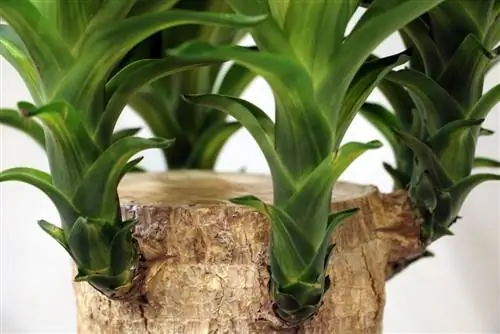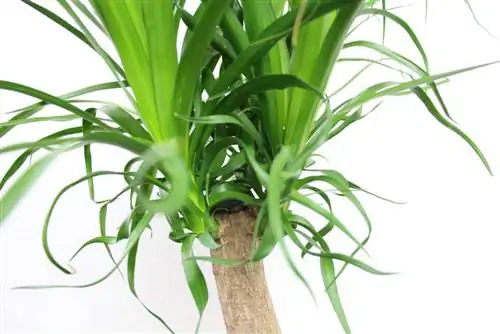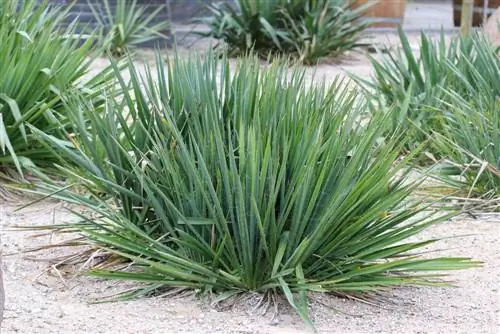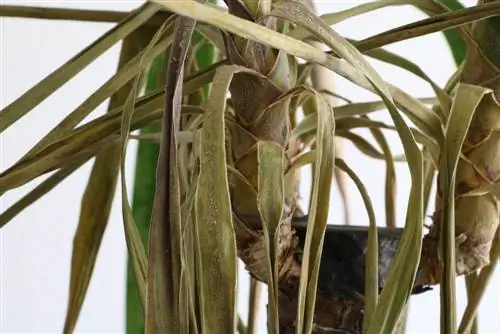- Author admin [email protected].
- Public 2023-12-17 03:39.
- Last modified 2025-01-24 12:45.
The giant palm lily or Yucca elephantipes, as it is known by its botanical name, is a long-lasting eye-catcher. Which also forgives many care mistakes. Undemanding and easy to cultivate, the giant palm lily reaches surprising heights and also looks extremely decorative as a single green in the room or balcony. Despite the low requirements, the yucca needs the right conditions so that it can thrive he althily and grow decoratively. With the following instructions, even beginners can do this easily.
Location
The giant palm lily prefers a warm, sunny location. A place by the window facing east, south or west is ideal for them. In the warm months it can also be left outdoors as long as it is adequately protected from cold winds and heavy rain. However, if the temperature falls below 15 °C, the yucca must be brought indoors. In addition to lighting conditions and temperatures, the available space is crucial. The giant palm lily grows quite slowly, but the size of a young plant should not be underestimated. Tip: Whether the chosen location is bright enough for the Yucca elephantipes can be seen from the leaves. If they are upright, the space is ideal. However, if they hang, there is no light.
Substrate
The giant palm lily is not a palm tree, but rather an agave, but you can still get palm soil well. As well as a mixture of equal parts potting soil, coconut fiber and sand. The substrate should be loose and permeable, but able to store water.
Pouring
The giant palm lily always wants to be moderately moist, at least during the warm months. Watering should therefore always be done when the top layer of soil has dried out a little. Waterlogging should be avoided, but a culture that is too dry will quickly end in brown leaf tips. In order to avoid this, it makes sense to spray the leaves regularly in addition to watering the yucca. This also applies to winter, when the earth can become a little drier.
In any case, the Yucca elephantipes should be treated to soft, low-lime water. Anyone who has the opportunity can collect rain for this purpose. Alternatively, you can also use tap water that has been left open for at least a week. The lime settles at the bottom, so the last bit should remain in the pot.
Fertilize
From spring to autumn, the giant palm lily needs additional nutrients in the form of fertilizer despite its very slow growth. Suitable products are liquid complete fertilizer or long-term fertilizer in stick form. If you decide to use liquid preparations, add them directly to the irrigation water and administer them every three to four weeks. Fertilizer sticks are repositioned every three to four months.
Blend
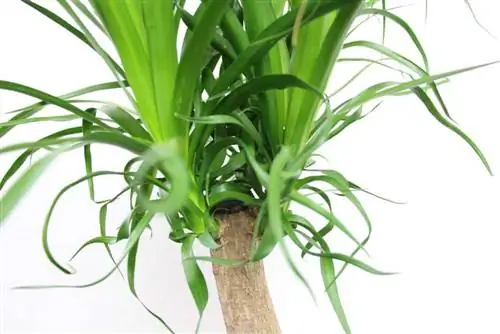
Every year, old leaves on the Yucca elephantipes die and dry out; these can be cut off directly on the trunk. However, a real topiary or other regular interventions are not necessary. With older giant palm lilies, the plant may simply grow too tall. Here it is possible to shorten the trunk to the desired height. After this procedure, the incision site should be treated with wound closure to prevent both dehydration and disease. The head part can then be used to propagate the yucca.
Propagation
The giant palm lily can be propagated by seeds or a stem cutting. Propagation via seeds is done as described here:
- The seeds of the giant palm lilies are placed in lukewarm water and left there for about a day to swell.
- Following this preparation, the seeds are placed on the planting substrate and covered with it only very thinly. Coconut fibers or potting soil are suitable.
- Instead of watering the soil and immediately washing it away, the initial watering should be done with a flower sprayer.
- Germs show up slowly and can take up to two months to appear. To promote growth, the substrate should be kept moist.
- Once the young plants have reached a height of 15 cm, each yucca should have its own planter.
- For propagation by stem cutting, at least 20 cm of the plant head is cut off. This unusual cutting is placed in soil immediately after cutting.
- Poting soil or growing soil can also be used here. A mixture of sand, coconut fibers and potting soil is also suitable.
Tip:
The use of root aid makes sense for propagation through root cutting.
Wintering
Whether the Yucca elephantipes spent the summer outdoors or is kept in the living room all year round, it does not need a cool winter quarters. Instead, it should be cultivated at normal room temperatures. In preparation for winter rest, watering is gradually reduced in the fall. However, complete drying of the substrate should be avoided. The plant should also be sprayed with water once a week; this measure protects against pests and diseases. Fertilization, however, can be suspended completely.
Typical diseases, care errors and pests
Diseases and pests occur with the travel palm lily almost exclusively when there are long-term errors in care. If the Yucca elephantipes is exposed to constantly changing temperatures and different levels of humidity, it becomes susceptible to fungal infections. These manifest themselves in musty smells, deposits on leaves and on the soil, and wilting plant parts. The best prevention against this is a location indoors. At least when the weather is very changeable. If the infestation has already occurred, the substrate must be changed and the plant treated with a fungicide.
Pests are more common in winter if the yucca is kept too dry. As a prevention against this, spraying the giant palm lily with water is recommended. If the damaging insects, such as scale insects and spider mites, are already found on the leaves, subsequently increasing the air humidity and using insecticides will help.
Frequently asked questions
Is the giant palm lily poisonous?
The Yucca elephantipes is considered safe for adults. However, it is toxic to animals and small children. The giant palm lily is therefore out of place in households with pets who like to feast on houseplants or small children who play wildly.
Why doesn't Yucca elephantipes bloom?
As slowly as the yucca grows, it also takes a long time for its flowers to form for the first time. Several years are necessary for the giant palm lily to reach the required maturity.
What you should know in brief
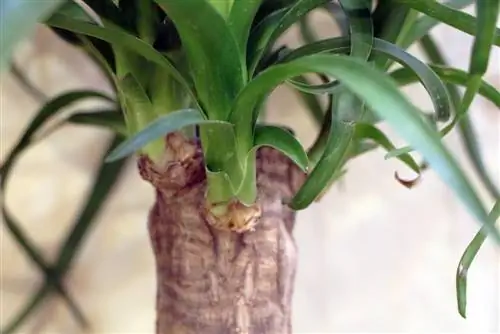
The Yucca palm is actually not a palm tree, but belongs to the agave family. Its homeland is in Mexico, where it grows primarily at altitudes of 2000 meters. In the wild it can grow up to ten meters high, but as a house or garden plant it also grows very quickly and is very easy to care for and therefore also suitable for beginners.
Care
- The Yucca needs a bright to sunny place, but it can also get used to a partially shaded location.
- She only needs a little water. It is better to let the soil in the planter dry out a little before watering the next time.
- A yucca is often used as a houseplant, but in summer it can also be placed on the terrace or balcony.
- It usually flowers too, but this is hardly to be expected with houseplants and if it does, then only with older plants.
- During the growing season, a yucca should be fertilized every two weeks, then it can easily reach an impressive size.
- If the ball is completely rooted, the plant should be repotted into a larger container. This is best done in spring.
Wintering
- In winter, a yucca should only be watered very sparingly at intervals of several weeks because the plant likes to have a rest period.
- A potted plant that is left outside in summer is best placed in a cold and bright place at around 5 to 10° C during the cold months.
- In warmer areas or in a very sheltered place it can stay outside because it can tolerate frost for a short time.
Cutting and propagation
- A yucca grows very quickly and can therefore sometimes become too large. Then the trunk can be cut back.
- The cut trunk can then be divided into several pieces and planted in potting soil, where each section forms new roots.
- It is important to ensure that the pieces are not turned and placed upside down in the ground.
- The soil should be kept quite dry, as soil that is too moist can cause the trunk sections to begin to rot.
A yucca can also be propagated by kindling, i.e. shoots that occasionally form on the plant. Once they have already formed a few leaves, these are cut off in spring, placed in potting soil and kept slightly moist. To do this, the leaves are sprayed with water every day. During the initial period, the cuttings should be placed in bright light, but not in direct sunlight. There they initially form roots and sprout additional leaves over time, although this process can take a few months.

